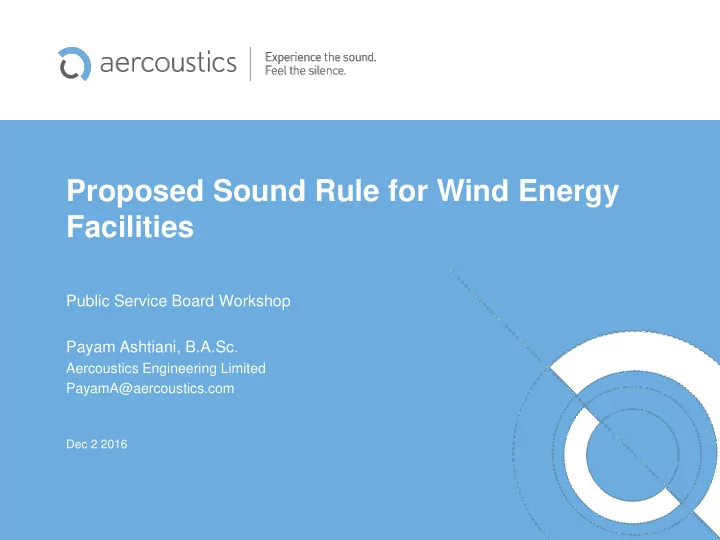

Proposed Sound Rule for Wind Energy Facilities Public Service Board Workshop Payam Ashtiani, B.A.Sc. Aercoustics Engineering Limited PayamA@aercoustics.com Dec 2 2016
Noise Emission vs Noise Immission Emission: Noise emitted by a source Immission: Noise received at a given location
Noise Emission vs Noise Immission Emission: Noise emitted by a source Immission: Noise received at a given location Emission Immission
PRE-CONSTRUCTION NOISE MODELLING Permitting Stage
Pre-Construction Noise Modelling • Industry accepted modelling methodology agrees well with post construction measurements. • Modelling methods should be standardized and prescribed • Institute of Acoustics Good Practice Guide – May 2013 • ISO 9613-2 widely accepted • Modelling parameters important: - Ground factor (<=0.5) - Termperature / Humidity - Sound Power input used (Uncertainty considerations) - Considerations for concave ground (valleys)
POST-CONSTRUCTION NOISE MONITORING Commissioning stage or in response to noise complaints
Post-Construction Noise Monitoring Informed by the past decade of measuring noise from large wind turbines Unattended simple noise monitors – short term Circa 2005-2007 Circa 2007-2008 Attended measurements short to medium term Sophisticated unattended noise monitors – long term Circa 2008-2010 More robust, cell connected noise monitors – long term Circa 2011-present Circa 2014-present Algorithms for objective tonality assessment
Post-Construction Noise Monitoring - instrumentation • Class 1 sound level meter and microphone • Secondary wind screen for added protection against wind induced pseudonoise • Anemometer located near microphone • Wind speed • Wind direction • Temperature • Humidity • Pressure • Rain
Post-Construction Noise Monitoring - location • Preferably at locations with the highest predicted noise impact from the facility • Locations where one can reasonably expected downwind conditions to occur more frequently than others. • Locations that are free of significant sources of noise contamination such as busy roadways, heavily shrubbed or forested areas, or close to other commercial operations
Post-Construction Noise Monitoring – data filtering • 1-minute intervals
Post-Construction Noise Monitoring – data filtering 11
Post-Construction Noise Monitoring – data filtering • 1-minute intervals • Valid if conditions are conducive to good quality data: - No precipitation - Separate daytime from nighttime (different fauna) - Ensure turbines operating at high noise output - Wind direction is not upwind (i.e. only downwind and crosswind acceptable) - Wind speed measured at ground level less than 5m/s to minimize ambient noise. - Remove intervals with transient events such as car passbys, etc • Obtain sufficient number of valid data points with Turbines ON and OFF • Bin the data by wind speed and compare ON vs OFF • Determine the Turbine contribution through logarithmic subtraction of ambient
Post-Construction Noise Monitoring – data filtering
Post-Construction Noise Monitoring – assessment • Assessment made based on the mean or logarithmic average of the levels by windspeed • Facility contribution determined by ambient correction with data from the same wind bin • Assessment made when there is sufficient data acquired – at least 20 points within a wind bin • NOTE: Any 1 individual minute above or below the limit does not constitute an assessment of compliance or non-compliance. • NOTE: the nature of ambient noise is changing constantly and it would be difficult to defend certainty in knowing if one individual minute was not unduely influenced by transient event contamination 14
Tonality • Tonality determined by analyzing narrow-band frequency spectra • Objective measure of the prominence of a tone • Less prone to false negatives than the current 1/3 rd Octave method
Thank you Payam Ashtiani, B.A.Sc. Aercoustics Engineering Limited PayamA@aercoustics.com Dec 2 2016
Recommend
More recommend